
(Photo by Ayala Moriel)
Carrying on the theme of posts on organisms that are somehow associated with dragons, we now come to another interesting group of plants.
The genus Dracaena is a group of about 40 species, belonging to the family Asparagaceae. Yes, they're distant relatives of the asparagus we eat (Asparagus officinalis). The name comes from ancient Greek - δράκαινα (drakaina, or 'female dragon'). The majority of species are native to Africa, with a few in southern Asia and one species in Central America. The hala pepe (Pleomele spp.), 6 tree species endemic to Hawaii, are closely related, and are commonly included in Dracaena, as are the 70 or so species of mother-in-law's tongue or snake plants (Sansevieria spp.) of Africa.
Several species of Dracaena grow to large sizes, and are known by the common name of 'dragon tree'. Perhaps the most familiar of these would be the Canary Islands dragon tree (Dracaena draco), originally found in the Canary Islands, Cape Verde, Madeira, and parts of western Morocco. It's commonly grown as an ornamental plant due to its shape, which is the result of its interesting growth pattern.
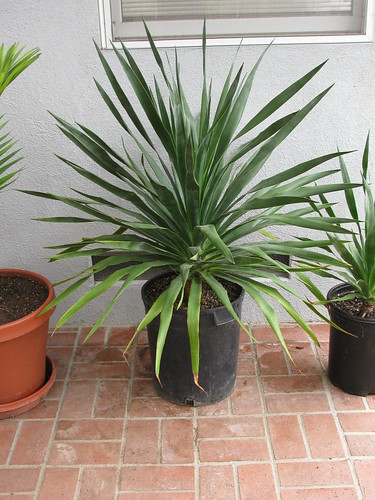
(Photo by hellos1011)
When young it does not look like a tree at all, and has a single stem.
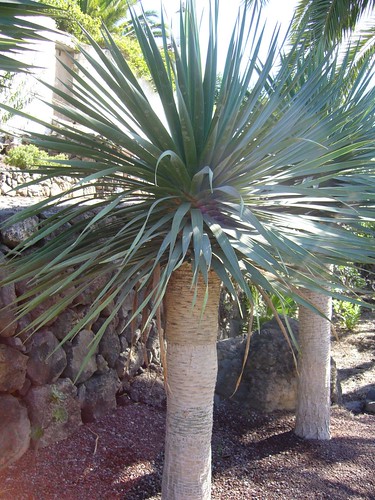
(Photo by Mike Peacock 2005)
At about 10–15 years of age the stems stops growing and produces a flower spike with white, lily-like perfumed flowers.

(Photo by Milhafre)
These are then followed by small red berries.
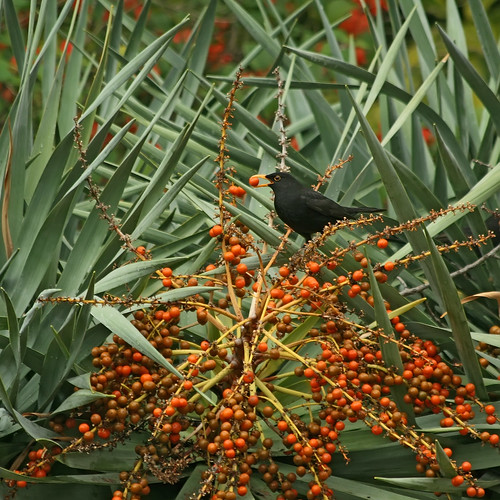
(Photo by Mr.Enjoy)
Soon a crown of terminal buds appear and the plant starts branching. Each branch grows for about 10–15 years and re-branches, so a mature plant takes on an umbrella-like shape.
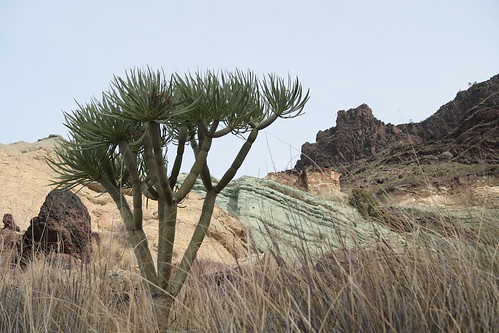
(Photo by Jano Labs)
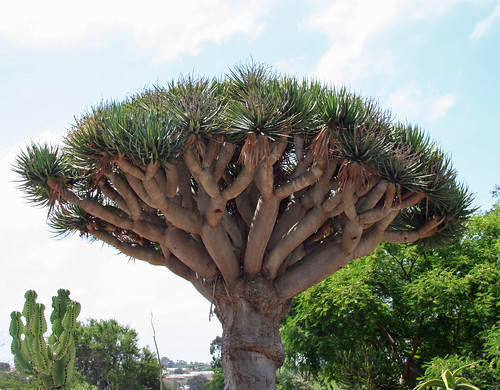
(Photo by Abraxas3d)
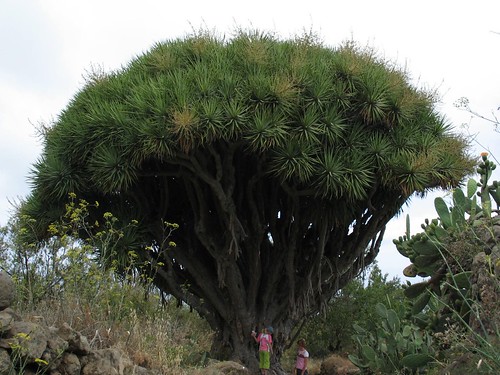
(Photo by dorien)
One particularly notable individual stands close to the Church of San Marcos in Icod de los Vinos, on the island of Tenerife in the Canary Islands. Growing 22 metres in height, it is said to be a thousand years old, hence its local name, El Drago Milenario ('Thousand-Year-Old Dragon'). Unfortunately, it is impossible to verify this claim, as Dracaena do not lay down annual rings in their trunks, so you cannot tell its age by counting the rings. Still, it is possibly several hundred years old, and is an icon of the area.
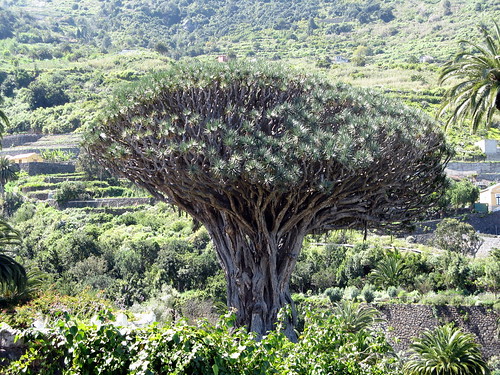
(Photo by Nellie Dean)
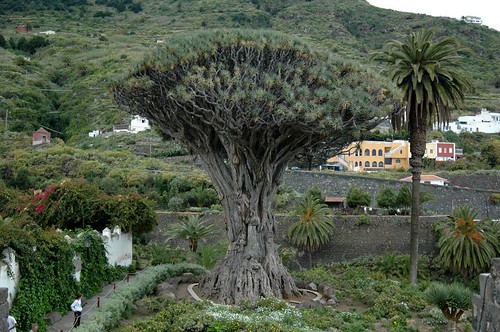
(Photo by Los viajes de Jota)

(Photo by Aitor Améztegui)
Despite being common in horticulture, where it is considered a hardy houseplant that does not require a lot of watering, in the wild populations of Canary Islands dragon tree have declined to such an extent that it is considered Vulnerable to extinction due to habitat destruction and grazing. Several hundred individuals are still present in the Canary Islands, whereas in Madeira, where the species was once an important component of the vegetation in more arid areas, the population has declined to just 2 individuals. Another population is found in the Cape Verde Islands, while several thousand were discovered in the mountains of western Morocco only in 1996.
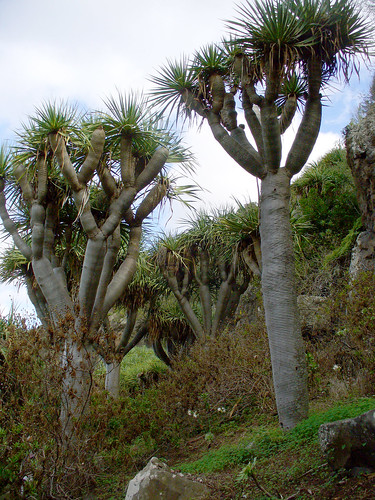
Gran Canaria dragon tree (Dracaena tamaranae), Gran Canaria;
(Photo by scott.zona)
Another species, the Gran Canaria dragon tree, was recognised as a distinct species only in the late 1990s. Endemic to the island of Gran Canaria in the Canary Islands, where it grows on exposed cliffs and escarpments, it is known to occur only in a few localities, and so most probably qualifies for Critically Endangered status.
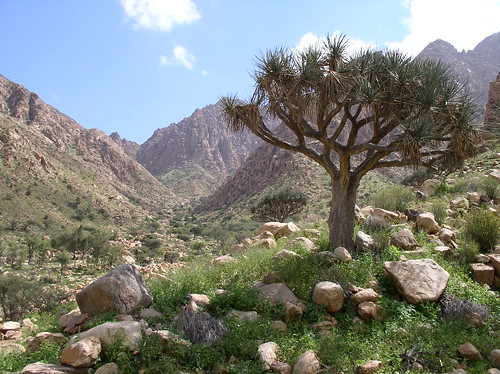
Nubian dragon tree (Dracaena ombet), Egypt;
(Photo by Bassem Amer)
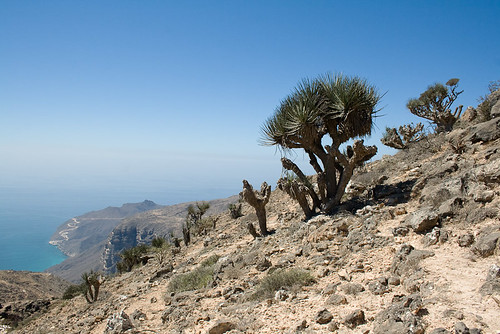
Yemen dragon tree (Dracaena serrulata), Oman;
(Photo by Johannes D. Mayer)
The Nubian dragon tree is an Endangered species that grows on mountains in the deserts of northern Africa, in countries like Egypt and Sudan, with the Ethiopian and Somalian populations sometimes considered to be a separate species, the Ethiopian dragon tree (Dracaena schizantha). The Yemen dragon tree, another Endangered species that grows in similar habitats in the southern Arabian Peninsula, might possibly belong to the same species as the Nubian dragon tree.
One more species of dragon tree, the Socotra dragon tree (Dracaena cinnabari), is a Vulnerable species that is a flagship for the endemic flora of Socotra, a small island off the Horn of Africa.
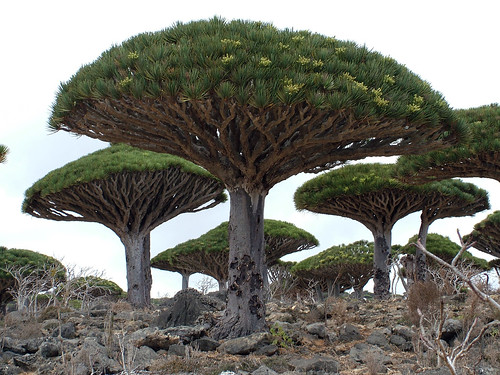
(Photo by Edoardo Scepi)
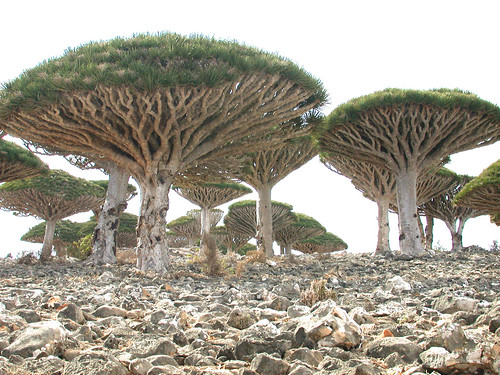
(Photo by jan_vandorpe)
Interestingly enough, the Canary Islands dragon tree and Socotra dragon tree are supposedly more closely related to one another, while the Gran Canaria dragon tree appears to be more closely related to the dragon trees of mainland Africa and the Arabian Peninsula. It has been suggested that the current distribution of dragon trees is a relict of a time when these plants were more widespread across northern Africa, millions of years ago.
As the Sahara spread, the dragon trees retreated to the eastern and western edges of the continent, where there is more moisture due to winds blowing in from the sea. 1 lineage of dragon tree managed to colonise the Canary Islands and Morocco in the west and Socotra in the east, giving rise to the Canary Island and Socotra dragon trees respectively. Another closely related yet separate lineage also inadvertently ended up with a similar distribution, with the western population in the Canary Islands surviving today as the Gran Canaria dragon tree, and the eastern populations, which were separated from one another by the many rift valleys in the region, evolving into the Nubian, Ethiopian, and Yemen species.

A: Dispersal and colonization from the African mainland make the Macaronesian Islands a refuge for several species of Dracaena;
B: African Grand Rift leads to the disruption and vicariance of Dracaena in the Red Sea region;
(Diagrams from Marrero et al., 1998)
The dragon trees get their common name from the reddish sap that is exuded when the bark is cut, which is known as dragon's blood. Pliny the Elder wrote that this substance was produced by the mingling of blood from a battle between an elephant and a dragon, while another myth states that dragon trees sprouted from the blood of Landon, the hundred-headed dragon slain by Hercules.

Dragon's blood;
(Photo by Andy Dingley, from Wikipedia)
In ancient Rome, dragon's blood was used as a dye and medicine, in incense, and in alchemy. Until the Medieval and Renaissance periods, when the reddish sap of other plants was also extracted and marketed as dragon's blood, the primary source of this substance were dragon trees, in particular the Socotra and Canary Islands species. In the 18th century, dragon's blood was used as toothpaste, and also as a wood varnish for Italian violin-makers.
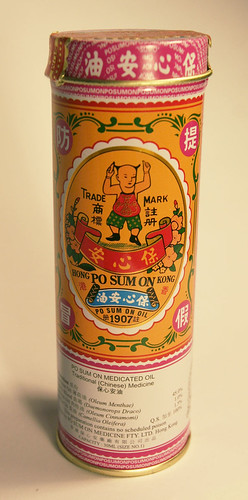
Dragon's blood is apparently an ingredient in this traditional medicated oil from Hong Kong;
(Photo by Jason Pym)
Today, however, due to their threatened status, extraction of sap from dragon trees has declined greatly. Instead, dragon's blood is more likely to consist of resin extracted from the sap of other Dracaena species, especially Dracaena cochinchinensis from southern China and Indochina, or from the fruits of Southeast Asian rattan palms, in particular several species of Daemonorops and Calamus rotang. Other plant species, such as the bloodwood tree (Pterocarpus officinialis) of tropical Central and South America and the Caribbean, various species of croton (Croton spp.) of Central and South America, and leatherstem (Jatropha dioica) of northern Mexico and southern United States, also produce a red latex that has been gathered and sold as dragon's blood.

Leatherstem;
(Photo by jphirata)

Grove of Sangre de Grado (Croton lechleri);

Trunk of Sangre de Grado, showing cuts that have been made to stimulate the flow of sap;
(Photos by rickpickett)
Dragon's blood is still used as a varnish, in photoengraving, in incense, as a body oil, and in traditional medicine, although the properties definitely vary depending on the species of plant used as the source of dragon's blood. There doesn't seem to be any real distinction being made between dragon's blood extracted from dragon tree sap, or resin from other plant species. Similarly, the Roman definition of dragon's blood also included mixtures that incorporated the toxic compound cinnabar (mercury sulphide).
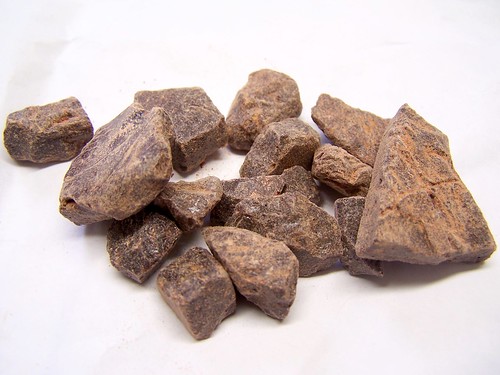
(Photo by sandySTC)
The rest of the Dracaena species are smaller shrubs that grow in tropical forests. Many of these are popular in the ornamental plant trade. One species in particular features quite heavily in Chinese New Year decorations.
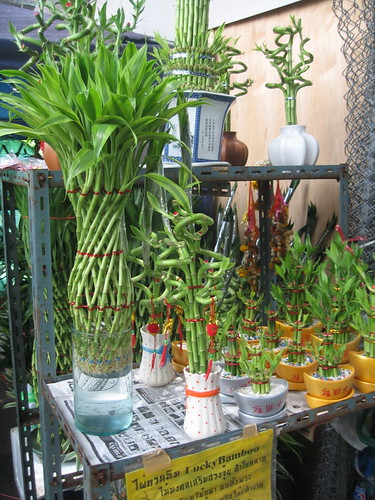
(Photo by gr8fyl1973)

(Photo by bernardoh)
In many Asian markets and florists, it is easy to come upon what is called 'lucky bamboo', stem cuttings that have been bent and twisted into elaborate shapes, and often considered to bring good luck and fortune.

(Photo by {shilpa})
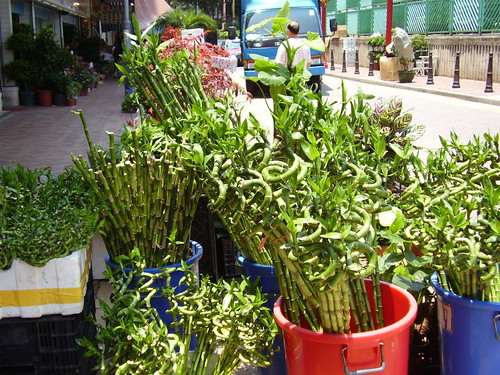
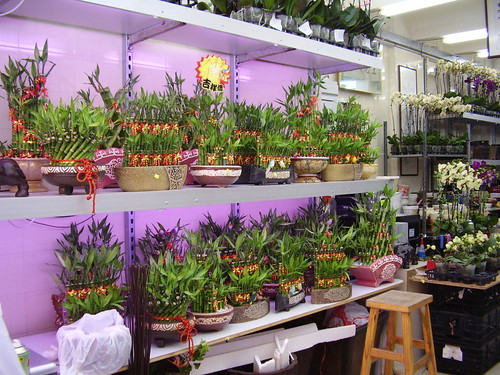
(Photos by Tom and Jules Frost)
These stalks aren't actually bamboo (Bambuseae, F. Poaceae), but are those of a Dracaena known as Dracaena sanderiana. It is a shrubby plant that grows in the understorey of rainforests in Cameroon, west Africa, but due to its recent 'rebranding' and marketing as being good for feng shui, has suddenly seen an upsurge in popularity in Chinese communities around the world. Naturally, this is a very recent development, and goes to show the power of marketing strategies, especially when it concerns superstitious beliefs in Chinese culture.
The twists and spirals are created by altering the direction of light, as well as through binding and tying the stems. As the stalk grows, it tends to grow towards the light, and by subtly shifting the light source, one can soon create a spiral.
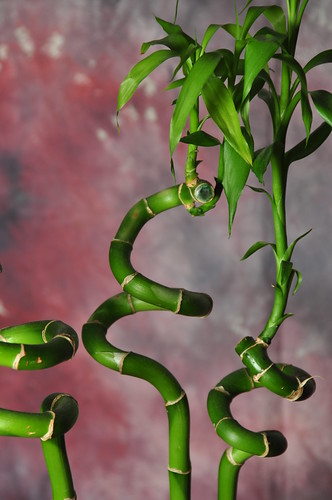
(Photo by photographer695)
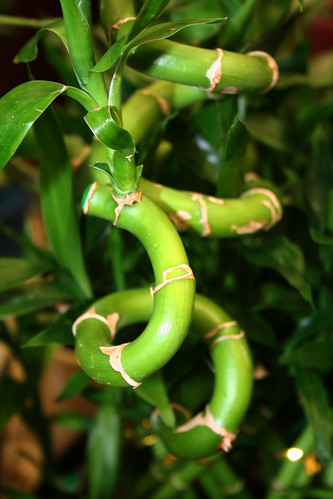
(Photo by williewonker)
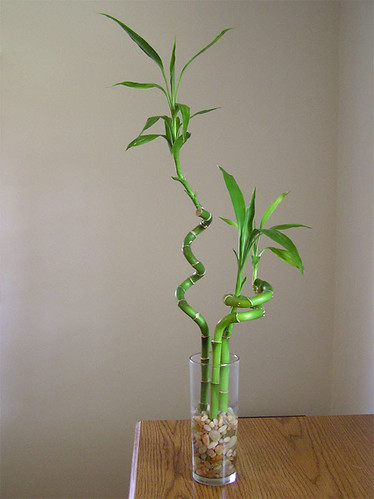
(Photo by Andrew Vogel)
There are even more complicated patterns, which are more expensive.
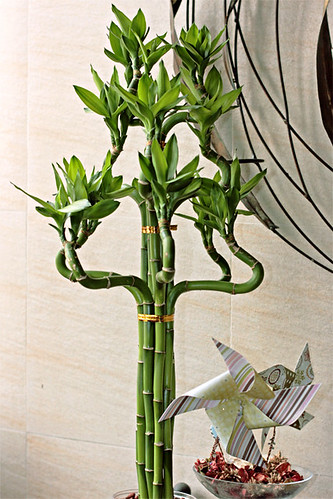
(Photo by Pics @ Jiny's)
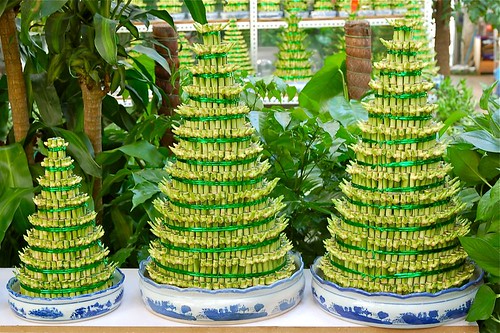
(Photo by Ian Riley)
Dracaena sanderiana is a hardy plant that isn't too demanding and does well indoors, so these stalks should survive for some time, although it is generally recommended that one transfer these stalks of 'lucky bamboo' to a proper pot with soil if one decides to grow them in the long term.

(Photo by LeticiaTootington)
Coming up next, another plant that has been associated with dragons.